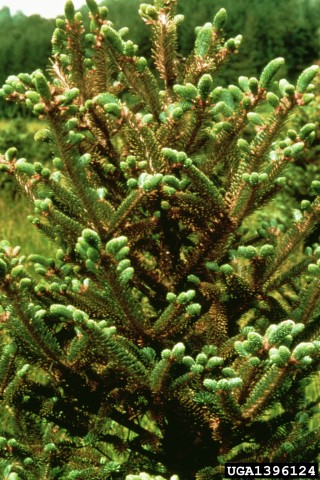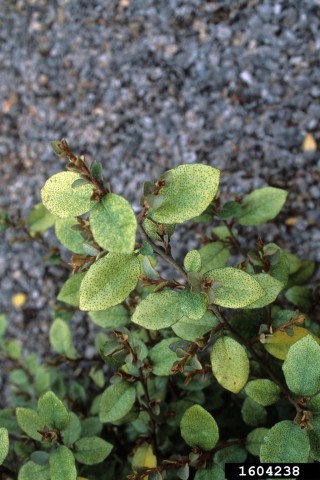
Spruce spider mite damage. Photo: USDA Forest Service, bugwood.org.

Spider mite damage on leaves. Photo: John Ruter, University of Georgia, bugwood.org.
Have you noticed damage on some of your plants in this hot, dry weather? It could be spider mites. Mites are common pests in landscapes and gardens.
Spider mites damage plants by sucking juice from the underside of leaves. Unfortunately, they are often not noticed until damage becomes apparent.
Identifying spider mite damage: On conifers, foliage turns yellow or brown and may eventually drop off.
On leaves, spider mite damage initially looks like small yellow or brown spots (stippling). Leaves might turn yellow, reddish or pale and drop off. You may see webbing on the underside of infested leaves.
Host plants: In our area, spider mites most commonly afflict skimmia and dwarf Alberta spruce. They may also affect other plants, such as arborvitae. They are also common on houseplants.
Identifying spider mites: Spider mites are tiny arachnids (spider relatives) with eight legs and no wings. To the naked eye, they may be invisible or may look like tiny moving dots. They are easily seen with the aid of a magnifying lens. There are a variety of species and colors.
Check the undersides of leaves for mites, their eggs and webbing. You can hold a piece of white paper under a branch and hit the branch sharply. The little dots on the paper that start to walk away are mites.
In order to successfully control mites, you need to understand their life cycle. Most species overwinter as eggs on host plants. Mites become active in the spring. There may be eight to ten overlapping generations per year.
Spider mites prefer hot, dusty conditions. Damage is most severe during hot and dry periods when mites dehydrate and must feed more frequently to re-hydrate. Plants under water stress are highly susceptible to mite damage.
What you can do to manage spider mites
- If you have skimmia or dwarf Alberta spruce, monitor for spider mite damage so management can begin early.
- Keep plants well watered. This is the cornerstone of limiting mite damage.
- Spray the plants (especially the leaf undersides) with a hard, cold water spray several times a day for several days. This will knock many of the mites off.
- Water sprays also raise the humidity around the plants, reducing the mites’ need for moisture and feeding. With enough moisture, natural predators are often able to maintain spider mite populations at harmless levels.
- Mulch around your plants to reduce drought stress.
- Pay special attention to water needs of plants under eaves. Make sure to water the sides of plants facing the house.
- Spider mites have many natural enemies, including predatory mites, lady beetle adults and larvae, lacewing larvae, thrips and minute pirate bugs. These will help limit their numbers, especially when pesticides are not used in the garden.
Consider replacement plant options
You may want to consider replacing your skimmia and dwarf Alberta spruce with plants that are less prone to problems with spider mites.
- Skimmia replacements: Consider sarcococca, mahonia and salal. All of these have a similar size and interest.
- Dwarf Alberta spruce replacements: Unfortunately, there are no plants that will provide a similar shape and form without constant pruning. You may need to try a plant with a different appearance.
For more information
- Spider mites, University of California IPM Program.
- Landscape pests-Spider mite, Pacific Northwest Insect Management Handbook.

Thank you, that was very helpful information. In general, I would love to see more posts on pest (insect) management. I believe I have a problem with thrips on my annuals. Is it ok to spray the flowers with insecticidal soap when there are no other good bugs around, or when bees are not active? The thrips (if that is what they are) are quite damaging to the flowers. Thanks!
You’re welcome. I’m glad it was helpful. We will try to add more posts on managing pests. Insecticidal soap is the least harmful product you can use, so that would be a good choice for managing thrips, and it should help the problem. As you said, you do want to look for bees or other beneficial insects before spraying. There are small native bees that are not as obvious as the large black-and-yellow bees, so it may be hard to know if you’re harming something. Here is a page from the University of California IPM program about managing thrips: http://ipm.ucanr.edu/PMG/PESTNOTES/pn7429.html.
Thank you so much. I just cut down the horribly diseased Photinia fraseri that was shading my Skimmia. I thought that opening up the sun in this location would result in Skimmia mites, something I’ve had with Skimmia in the past. This Skimmia under the Photinia was perfectly healthy and not watered much. Now I will be watering it, thanks to your good advice. I will also plant another tall evergreen to shade it. Thanks again.
You’re welcome! We’re glad it was helpful.